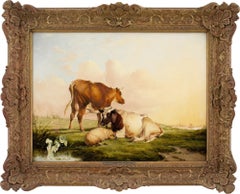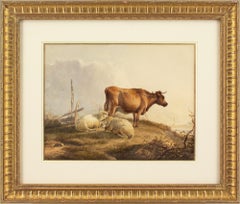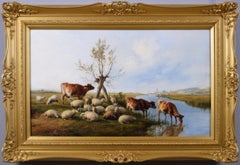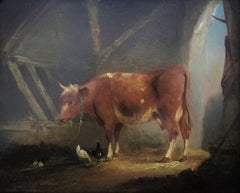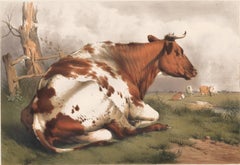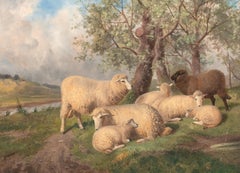Thomas Sidney Cooper Art
Thomas Sidney Cooper was one of the foremost animal painters of the Victorian period. He was greatly encouraged by Abraham Cooper (of no relation) and Sir Thomas Lawrence. Cooper entered the Royal Academy Schools before taking up a position as a teacher in Brussels in 1829. He was also influenced by the 17th century Dutch School. In 1831, the artist settled in London and first exhibited at Suffolk Street in 1833. He exhibited 48 pictures at the British Institution between 1833–63. Landscape and Cattle at the Royal Academy of Arts in 1833 and was shown until 1902 without a break; it was a record for a continuous exhibit at the Royal Academy of Arts. Sheep and cattle were his most frequent subjects, although he did paint a few figurative ones as well. His studio sale at Christie’s lasted three days from 12–15 April 1902. His works can be found in the Birmingham Museum & Art Gallery; the Blackburn Museum & Art Gallery; the National Museum Cardiff, Wales; the Glasgow City Art Gallery; the Leeds Art Gallery; Leicester Museums and Galleries; the Walker Art Gallery in Liverpool; the Victoria and Albert Museum in London; the Wallace Collection in London and the National Gallery in London.
1850s Victorian Thomas Sidney Cooper Art
Oil, Canvas
19th Century Thomas Sidney Cooper Art
Oil
1850s English School Thomas Sidney Cooper Art
Paper, Watercolor
19th Century Victorian Thomas Sidney Cooper Art
Canvas, Oil
1870s Victorian Thomas Sidney Cooper Art
Paint, Oil, Panel, Wood Panel, Board, Wood
1830s Thomas Sidney Cooper Art
Paper
20th Century Thomas Sidney Cooper Art
Watercolor
1880s Realist Thomas Sidney Cooper Art
Canvas, Oil
Thomas Sidney CooperOil on canvas : Cattle near the cliffs of Herne Bay KENT by Thomas Syndey Cooper
19th Century Thomas Sidney Cooper Art
Oil, Panel
Early 19th Century Thomas Sidney Cooper Art
Canvas, Oil
19th Century Thomas Sidney Cooper Art
Oil, Panel
1830s Victorian Thomas Sidney Cooper Art
Lithograph
Mid-19th Century English School Thomas Sidney Cooper Art
Paper, Watercolor
1830s Victorian Thomas Sidney Cooper Art
Lithograph
1830s Victorian Thomas Sidney Cooper Art
Lithograph
2010s Pop Art Thomas Sidney Cooper Art
Board, Wood Panel, Wood, Paint, Stencil, Pencil, Felt Pen, Acrylic, Spra...
Late 19th Century Victorian Thomas Sidney Cooper Art
Oil, Canvas
1860s Victorian Thomas Sidney Cooper Art
Oil, Board
Mid-20th Century Victorian Thomas Sidney Cooper Art
Canvas, Oil
English Sporting ArtClassic British Sporting Art Oil Painting Huntsman on Horseback Winter Landscape
Late 19th Century Victorian Thomas Sidney Cooper Art
Canvas, Oil
Mid-19th Century Victorian Thomas Sidney Cooper Art
Oil, Canvas
Mid-19th Century Victorian Thomas Sidney Cooper Art
Oil, Wood Panel
1920s Victorian Thomas Sidney Cooper Art
Oil, Board
1830s Victorian Thomas Sidney Cooper Art
Canvas, Oil
20th Century Victorian Thomas Sidney Cooper Art
Oil, Panel
1910s Victorian Thomas Sidney Cooper Art
Oil, Canvas
1890s Victorian Thomas Sidney Cooper Art
Oil, Board
19th Century Thomas Sidney Cooper Art
Canvas, Oil
1850s English School Thomas Sidney Cooper Art
Paper, Watercolor
1830s Victorian Thomas Sidney Cooper Art
Lithograph
Mid-19th Century Victorian Thomas Sidney Cooper Art
Oil
1880s Victorian Thomas Sidney Cooper Art
Canvas, Paint, Oil
1890s Victorian Thomas Sidney Cooper Art
Canvas, Paint, Oil
19th Century Thomas Sidney Cooper Art
Oil, Panel
19th Century Old Masters Thomas Sidney Cooper Art
Oil
